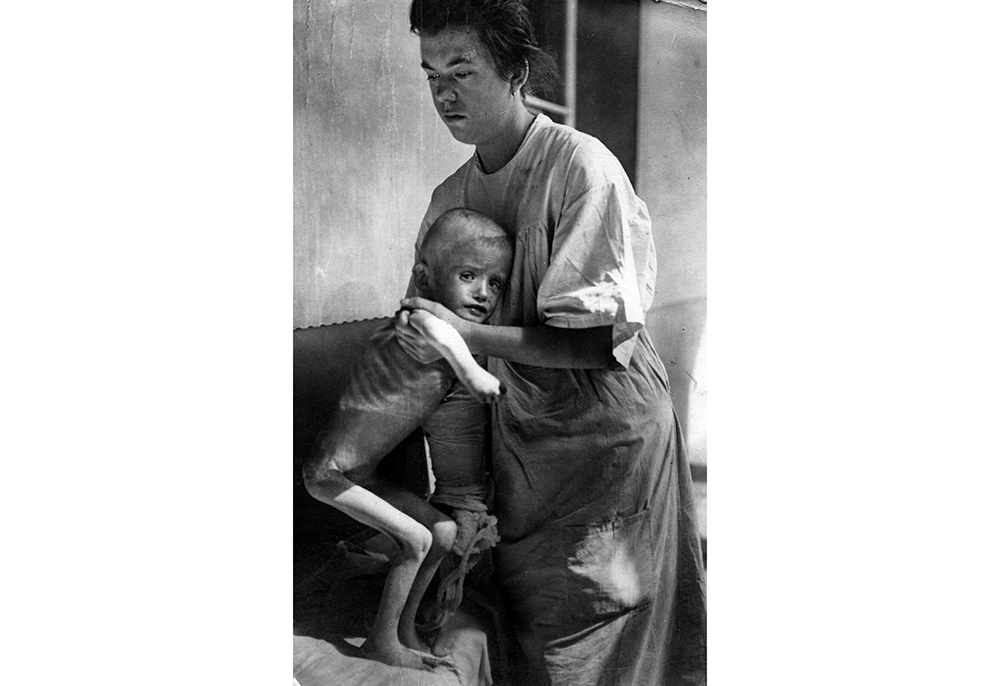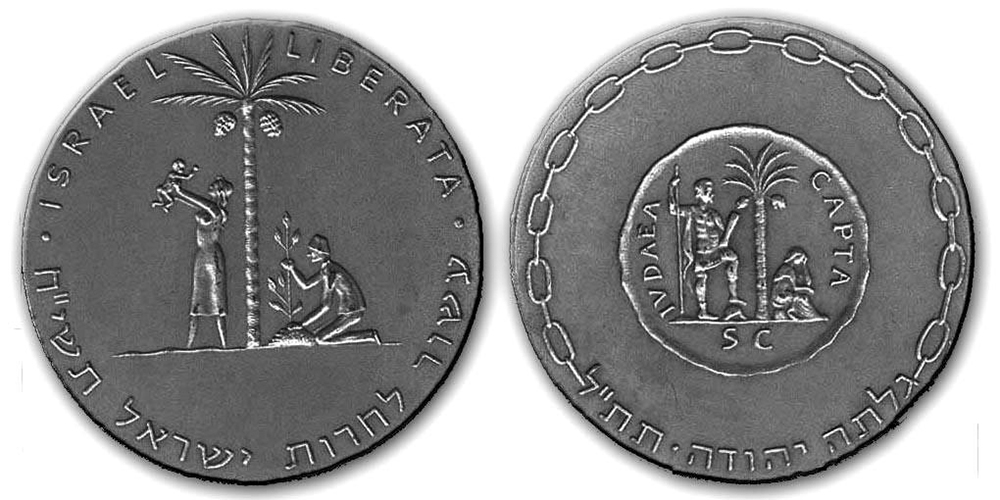A now-infamous photograph of October 7 recalls an ancient coin’s symbol of oppression and resilience.

(Printed with permission)
In 71 CE, the Roman emperor Vespasian, in consultation with the senate, issued a commemorative coin to honor his son Titus’ suppression of the Great Jewish Revolt and destruction of Jerusalem the previous year. There are many variations of the coin, several of which depict the emperor or a Roman soldier in full battle dress standing triumphantly and suggestively over a defeated Jewish woman hunched on the ground, in some versions with her hands tied behind her back. The implication of the scene is clear: He can do as he wishes to her, just as he has to Jerusalem. A date palm, representing Judaea, runs down the center and the image is encircled by the words “Judaea Capta” (Judaea captured).
One of the very first photographs that began circulating after the horrors of October 7 struck a terribly similar scene: Several armed men riding into Gaza on the back of a pickup truck with the body of Shani Louk, a 23-year-old Jewish woman, lying below them, half-naked, her leg dangling lifelessly off the edge of the truck. One of the men stands like the Roman soldier, knees bent in an athletic posture, pointing down at the body with one hand and brandishing a weapon in the other. A tree peeks out above his head in the center. Here, too, the implication is clear. (A viral video taken later showed Shani’s disfigured body being spat on and paraded as a trophy through the streets of Gaza.)
Many in the Jewish community were appalled when the photo was awarded, among others from the Associated Press, a first-place prize in the Pictures of the Year International awards, the oldest photojournalism competition in the world. A graphic snapshot of the Black Shabbat morning’s violence, it was, much like the coin, a token of Jewish suffering and mutilation. After the prize was announced, Nissim Louk, Shani’s father, took a different view:
It’s good that the photo won the prize; this is one of the most important photos in the last 50 years …. These are some of the photos that shape human memory, the Jew raising his hands, the paratroopers at the Western Wall, photos that symbolize an era …. This is history. In 100 years they will look and know what happened here.

(Credit: Wikimedia Commons)
But will they? The strange thing about photographs is just how reliant they are on context. In the words of theorist Roland Barthes, a photo “completely de-realizes the human world of conflicts and desires.” The critic John Berger went so far as to say that a photograph can be in “opposition to history.”
To illustrate the point, consider this photograph from approximately 100 years ago:
The story behind it is as tragic as any in human history, but is it not one of genocide as with similar photos you’ve seen. It is of a starving German child in 1919. The four-year allied blockade of Germany, primarily intended to prevent armament shipments, also prevented food imports and led to widespread famine. An estimated 300,000-424,000 German civilians died of starvation and malnutrition as a result.
War, in all its parts, is hell on earth. Here is Susan Sontag, writing about the emotional weight of war photography:
We can’t imagine how dreadful, how terrifying war is; and how normal it becomes. Can’t understand, can’t imagine. That’s what every soldier, and every journalist and aid worker and independent observer who has put in time under fire, and had the luck to elude the death that struck down others nearby, stubbornly feels. And they are right.
Who among us is capable of accurately intuiting a story or context from a photograph? The devastating photos coming out of Gaza today are served up on social media as evidence of genocide. Their likeness to the apocalyptic images of pulverized Berlin in April 1945—where children, some as young as 12 years old, tragically formed the last line of German defense—might, one day, serve as evidence of how thoroughly debasing and horrifying wars against genocidal regimes hiding underground can be. To quote Barthes again, a photograph “teaches me nothing.” If a picture is worth a thousand words, it can tell just as many lies. (Or many more in the age of AI.)
_____________________________
This is why the context of the Shani Louk photograph is so important. Its meaning 100 years from now will depend on the narrative in which it is placed, and who is telling the story. Much like Vespasian’s commemorative coin, the photograph is as evocative to those who celebrate her suffering and murder as it is to those who grieve it.
So here is some context: The photographer, Ali Mahmud, is said to have been riding along with the men who killed her or others on October 7. In this Mahmud is not alone; photojournalists are often embedded on all sides of any given violent conflict. Some of them surely support the violence. Some simply “record so other people ask”—as says the hardened photojournalist protagonist of Alex Garland’s recent drama “Civil War.” Regardless of the photographer’s stance, we have become addicted to the graphic images sent from the front lines, popping up, de-realized and decontextualized, in our news feeds every day (which may be partly why we, armed with our smartphones, are poised to see so many front lines around us).
For Jewish history, this is not new. Ever since Vespasian struck his coin, the lines between perpetrator and documentarian have often been blurred or nonexistent. In September 1941—82 autumns before the fraternities of Hamas, Palestinian Islamic Jihad, and other groups GoProed their atrocities—Heinrich Jöst, a Wehrmacht sergeant stationed near Warsaw, spent his 43rd birthday snapping pictures with his Rolleiflex inside the Jewish ghetto. Many of the images are as ghastly as you might imagine, and the captions, based on Jöst’s recollections many years later, as detached. One image, again of a Jewish woman on the ground, her cold, stiffened legs the most prominent feature in the frame, bears the caption:
This woman died in front of me. People were standing around her. No one helped her, because no one was able to help.
This “no one” apparently includes himself, and it reflects another of Barthes’s insights, perhaps especially true of Jöst:
All those young photographers who are at work in the world, determined upon the capture of actuality, do not know that they are agents of Death. This is the way in which our time assumes Death: with the denying alibi of the distractedly “alive,” of which the Photographer is in a sense the professional.
At the same time Jöst was shooting, Mendel Grossman, a Hasidic painter and sculptor, was also taking photographs, both in his capacity as official photographer for the ghetto administration, and secretly as a private resident of the Lodz ghetto. Grossman’s photos outlived him—he died, armed with his camera, on a forced march days before the German surrender—because he fought to preserve them. In her book “The Cruel Radiance: Photography and Political Violence,” Susie Linfield chronicled the life of these photos, from their discovery in numerous hiding places after the war to the loss of most of them to history when the kibbutz housing them in British Mandatory Palestine came under Egyptian control in 1948. The handful that remain have been recontextualized into the story of Jewish resistance and resilience. They are displayed at the Ghetto Fighters House, the first Holocaust museum in the world. The museum stands at Kibbutz Lohamei HaGetaot in northern Israel, founded by former partisans, survivors, and veterans of the Warsaw Ghetto Uprising. (The kibbutz is famous for its leading role in Israel’s vegetarian and plant-based meat-production industry in partnership with Nestlé, an ashes-to-seedlings story if ever there was one.)
Contextualizing Grossman’s photography in the story of Jewish rebirth is part of an ongoing tradition of Jewish reclamation of visual culture. There are many images of Jewish history that have an anti-Jewish provenance: Michelangelo’s Moses, Eduard Bendemann’s painting of Jews being taken captive to Babylon, the Arch of Titus. In 1913, the newly formed National Federation of Temple Sisterhoods, which would later become Women of Reform Judaism, began producing art calendars that reclaimed these images, and others, for the Jewish lifecycle. In doing so, according to Jessica L. Carr, a scholar of Jewish visual culture, “Jews could recontextualize images …. to shift the argument of the images to reflect concepts that are influenced by Jewish views of heritage.”
_____________________________
In 1958, the State of Israel recontextualized Vespasian’s artifact by issuing its own commemorative coin, a copper medallion containing an engraving of the original Judaea Capta coin on one side, and a new image on the other: a woman standing tall, proudly holding an infant high in the air, and a figure planting a new sapling in the ground, the signature date palm running down the center. The image is crowned with the words “Israel Liberata.”
The tree symbolism is particularly apt. Speaking on the first Yom Hazikaron (Israel’s Memorial Day) after he lost his daughter, Nissim Louk remarked that, when Shani was a little girl, she would run to the forest near their house, losing herself for hours among the trees.
Ahead of Tu B’Shevat, the Jewish National Fund (JNF) invited families of the 364 victims of the Nova massacre to plant new trees on the festival grounds at Re’im Forest. “The history of the people of Israel is not just a history of destruction, but also of resilience,” proclaimed JNF Chair Ifat Ovadia Luski.
Of the photographs and videos taken that day, one is of Ricarda Louk, planting a tree for her daughter, the woman in the coin.
Philip Getz is the managing editor of Sapir.









